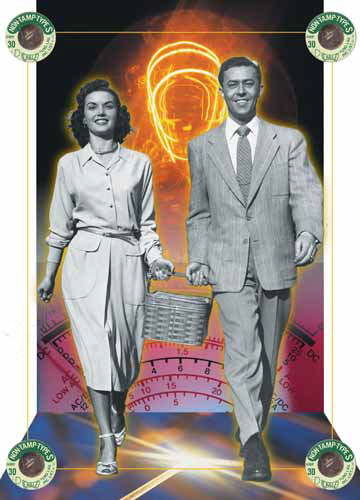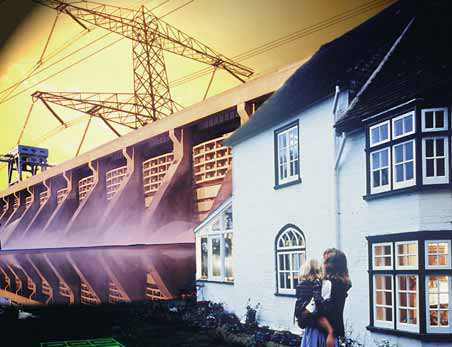Travelogues & History
There is no doubt about it - during the later years of the 19th Century, Thomas Edison was "Mr. Electric" in this country, and the electricity he promoted was direct current (DC). Last month, we took a look at the shortcomings of his DC system versus the alternating current (AC) distribution system that now serves us all so well. Now let's take a look at the personalities involved. In 1876, using
We're all advised to change the batteries in our smoke detectors once each year. This is truly good and affordable advice, and most of us are happy to comply. If you were to decide on a whim to replace all of the batteries in all of your battery-powered appliances or other devices that incorporate battery backup in their design on that mandated day, however, you might find the number of replacements surprising, the day a long one and the
Ever since the hydraulic principles of ancient Persia were 'rediscovered' by Europeans during the Renaissance, the sky has literally been the limit for watershape designers. At the 17th-century Dutch Palace of Het Loo, for example, fountain jets that trace their developmental history at least as far back as 8th-century Persia make an emphatic statement about the power of those who commissioned them. We all marvel, and rightly so, at the waterfeatures of Renaissance Italy, the pools of Versailles in France, the fountains of the
In the spring of 1941, my mom and dad, my sister and I moved into our brand-new house on Ardmore Avenue in one of northwest Detroit's real estate developments. It was a thoroughly modern house, with all of the latest high-tech features - the garage door moved upward to open, instead of swinging left and right like barn doors, and the furnace in the basement was operated by natural gas, eliminating forever the need to shovel coal. The house cost $5,550. From an electrical standpoint, the house was up to the codes and standards of its day - albeit a far cry from what is required today. The wiring was a two-wire system with no ground. All of the receptacles had two equal-size slots, and that was just fine because anything we wished to plug into these receptacles had a two-pronged plug at the end of its cord. A fuse panel in a bedroom closet contained four 15-amp fuses. That was it: four fuses to
As adults, we too often forget one of the great joys of childhood - the sense of wonder and discovery we experienced when we first saw the ocean or flew in an airplane and the world opened and unfolded before our very eyes. As designers, I believe we similarly forget about the excitement that comes with discovery. Too often, we lay out beautiful lines and incorporate interesting and unusual plant and hardscape material for everyone to see all at once. The work may be beautiful, but it leaves little or nothing to the imagination and offers no surprises. I can't help thinking how much more our landscapes, public and private, would be savored if they were to be explored and discovered bit by bit. This is especially true for spaces containing watershapes, which by themselves lend interest and drama to almost any space: The magic of water can (and I believe should) be exploited by concealing it at first and then revealing it in a way that gives the viewer a brief moment of visual revelation. To see what I mean with respect to watershapes and waterscapes, let's explore an approach that makes seeing everything immediately an impossibility. Instead, this approach offers glimpses that tantalize and intrigue - and can be seen in the work of thoughtful garden designers who've manipulated sights and sounds around the
Each year, the National Spa & Pool Institute offers special programs in conjunction with its International Expo. Most years, these programs include tours of local places of interest, such as notable museums, historical sites, outstanding examples of local architecture and the like. With the Expo in Las Vegas last December, NSPI took advantage of the location and included a tour of Hoover Dam and Lake Mead, a scant 30 miles from the glitz and glitter of The Strip. More than100
When I first begin to do research for a column, I really have little control over the direction I might take. If it's a cut-and-dried technical subject where I'll be dealing primarily with solid, scientific facts, the task is relatively simple. Using my own textbooks, two local libraries and the Internet, I look for my subject matter in a minimum of three separate sources. If the information is identical in each selected source, I feel pretty confident that I can use the data in an article. It isn't always so easy, however, and that's nobody's fault but
The gardening impulse of the Japanese is truly ancient. In times before recorded history, sacred outdoor spaces around Shinto shrines and Buddhist temples were arranged according to this design vision. And through more than 1,000 years of recorded history, gardens have been created and refined by priests, warriors and emperors alike in spaces both public and private. The style isn't original in the strictest sense: In many ways, the gardens of Japan find their sources in Chinese gardening styles and landscape painting. But the Japanese developed and refined their borrowings to fit their own national taste for subtle naturalism and elegant rusticity. The result is an amazingly coherent and distinctive landscaping style that now can be experienced at hundreds of public gardens in Japan. The nice thing today is that you don't have to live in Tokyo to appreciate Japanese gardens - or to incorprate their principles into your designs. In fact, garden designers around the world now use the obvious elements of Japanese gardens - the stone lanterns, gravel and clipped azaleas - in naturalistic and asymmetrical settings of all shapes and sizes. In some cases, the total look of the garden is Japanese; in others, its principles are used to
As designers and builders, we might feel with every new project that we have created the most profoundly original setting in the world. In most cases, however, our most likely achievement has to do with adapting an architectural concept developed long ago, putting a modern twist on it and calling it our own. For me, in fact, the more I learn about the history of watershaping, the more I feel connected to ancient watershapers and recognize that we haven't created anything really "new" in a long time. We all know clients, for instance, who want their backyards or public spaces to look like Spanish or Italian villas, French or English formal gardens, or maybe peaceful
During our last session, we explored the water-flow/electric-current-flow analogy and summed it up in a few sentences that are worth repeating: • Water: The pressure created by the pump forces water to flow through the pipes and valves, overcoming the friction losses of the system. Higher pressure provides for more gallons per minute. • Electricity: The voltage created by the battery forces electrons to flow through the wires and switches, overcoming the ohmic resistance of the circuit. Higher voltage provides for more amperes. (The short version of that is, "Volts push amps through ohms.") To be truly useful to us, we must know something about the way these three basic units relate to






















